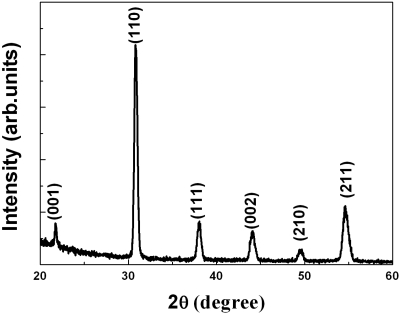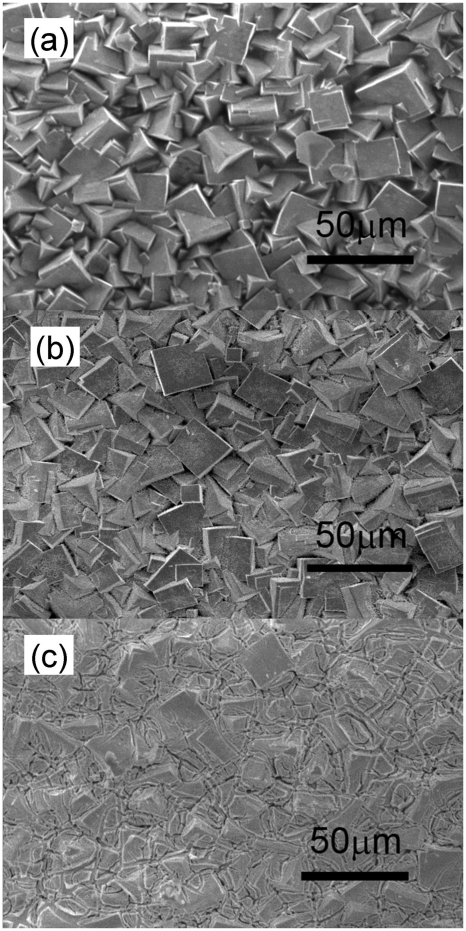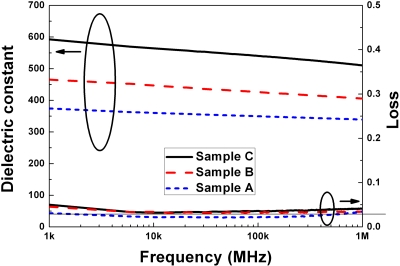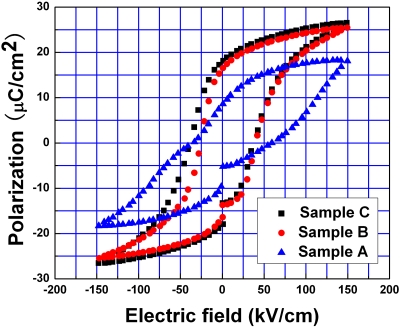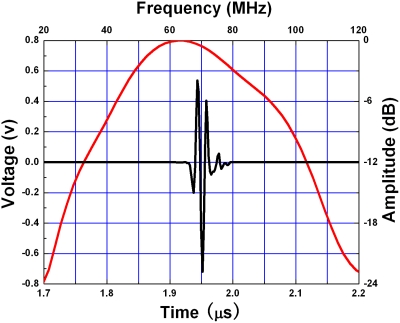Abstract
Using a simple rapid heating process, Pb(Zr0.52Ti0.48)O3 (PZT) thick films prepared by hydrothermal method were separated from a Ti substrate. Scanning electron microscopy (SEM) revealed that the self-separated films were crack-free. After solution infiltration and high temperature annealing, the PZT thick films were shown to possess good electric properties. At 1 kHz, the dielectric constant and the loss were 593 and 0.05, respectively. The remnant polarization was 30.0 μC∕cm2 at room temperature. A high frequency single element ultrasound transducer fabricated with these films showed a bandwidth at −6 dB of 73% at a center frequency of 67 MHz.
The desire to use ultrasonic imaging to examine the eye, skin, and blood vessels has driven the ultrasound frequency higher and higher. Transducers in the frequency range of 30–150 MHz have been developed to satisfy this need.1 One of the technical challenges in fabricating high frequency transducers is to prepare the piezoelectric element of a thickness on the order of only a few micrometers. It is very difficult and time consuming to lap down and mechanically machine very thin piezoelectric ceramics or crystals. Therefore, piezoelectric thick film technology may be a cost-effective alternative.
Compared with other piezoelectric films such as ZnO and AlN,2, 3 Pb(Zr0.52Ti0.48)O3 (PZT) films that offer much higher piezoelectric activity have been intensively investigated for high frequency transducer application. One of the most important processes of building transducer with thick films is to lift PZT thick films off a substrate because typically the substrate on which the PZT films are deposited is not an ideal backing material with low attenuation and acoustic impedance. Although different methods and substrates have been applied in preparing PZT thick films,4, 5, 6, 7, 8, 9 only XeF2 etching4, 5 and laser technology6 have been utilized to separate PZT thick films from Si or sapphire substrate. Among all synthesis methods,4, 5, 6, 7, 8, 9 hydrothermal method appears to be a promising way to deposit PZT thick films on Ti substrate on a large scale. Unfortunately, there has been no literature report describing how the hydrothermal PZT thick films can be peeled off from the Ti substrate. This has been a major obstacle preventing hydrothermal PZT thick films from being used for fabricating high frequency ultrasonic transducers.
In this letter, a simple self-lift-off technology will be reported. It is much cheaper than XeF2 etching and laser technology and can be easily used to separate hydrothermal PZT thick films from the Ti substrate, allowing it to be used for high frequency ultrasound transducer fabrication.
Approximately 30 μm PZT thick films were deposited on Ti substrate by the hydrothermal method according to the process depicted in Ref. 9. The hydrothermal PZT thick films with Ti substrate were annealed at a suitable temperature (above Curie temperature) with a fast heating rate in atmosphere. Then the PZT thick films (sample A) could be separated from the Ti substrate itself without any crack. Several self-separated films (sample B) were sintered at 950 °C for 1 h in furnace. Several self-separated films (sample C) were first immersed in PZT solution prepared by the method in Ref. 5 for 30 min; after 2 min heat treatment on hot plate at 200 and 400 °C and 1 min rapid thermal anneal at 650 °C, these films were sintered at 950 °C for 1 h in furnace.
The x-ray diffraction (XRD) pattern of hydrothermal PZT thick films on Ti substrate before heat treatment is shown in Fig. 1. The films appeared to be well crystallized and had the pure perovskite phase without any observed second phase, indicating that PZT thick films fabricated by hydrothermal method were randomly oriented and in polycrystalline structure.
Figure 1.
XRD pattern of hydrothermal PZT thick films on Ti substrate.
Figure 2 shows the scanning electron microscopy (SEM) surface pictures of the self-separated hydrothermal PZT thick films prepared under different conditions. Although sample A is the roughest one, it is crack-free. The surface of sample B becomes smoother because high temperature sintering may make grains grow more uniformly. Sample C has the smoothest surface; the reason is that PZT solution filled the pores and made the films much denser.
Figure 2.
SEM surface micrographs of the PZT thick films: (a) without infiltration without high temperature sintering, (b) without infiltration with high temperature sintering, and (c) with infiltration with high temperature sintering.
As shown in Fig. 3, no matter what the frequency is, the dielectric constant of sample C is always larger than those of samples A and B. At 1 kHz, the dielectric constants of samples A, B, and C are 374, 465, and 593, respectively. The dielectric response originates from both intrinsic contribution and extrinsic source. For samples A, B, and C, the intrinsic dielectric constants are similar, which are independent of thicknesses, grain sizes, and preferred orientations. The extrinsic contribution increases with both film thickness and grain size.10 Sample B has a larger grain size than sample A, while sample C is denser and thicker than sample B, so the dielectric constant results obtained could be proved in reason. From 1 kHz to 1 MHz, the dielectric losses of samples B and C are similar and slightly larger than that of sample A but are still in the range of 0.033–0.050, which is low enough for device applications.
Figure 3.
Frequency dependence of the dielectric constants and losses of the PZT thick films (sample A: without infiltration without high temperature sintering; sample B: without infiltration with high temperature sintering; sample C: with infiltration with high temperature sintering).
The ferroelectric hysteresis loops of the three kinds of PZT thick films are shown in Fig. 4. Different from samples B and C, sample A has an asymmetry loop. Without high temperature heating or long time sintering in atmosphere, it is of no surprise that there are many oxygen vacancies in sample A. Pinning effect11 caused by oxygen vacancies might be the main factor that influences the ferroelectric hysteresis. It can be seen that at the same high field level of 150 kV∕cm, the remanent polarizations (Pr) of samples A, B, and C are 8.4, 16.3, and 18 μC∕cm2, respectively. If the applied electric field is increased, sample A will break down. The maximal electric field that can be applied on sample B is 250 kV∕cm but sample C can sustain more than 300 kV∕cm electric field. It is worth noting that the maximal remanent polarization of sample C can reach as high as 30.5 μC∕cm2, which is close to that of PZT bulk materials sintered at high temperature (35 μC∕cm2). The results suggest that high temperature sintering and solution infiltration can enhance the ferroelectric property of self-separated hydrothermal PZT thick films.
Figure 4.
Polarization–electric field hysteresis loops of the PZT thick films (sample A: without infiltration without high temperature sintering; sample B: without infiltration with high temperature sintering; sample C: with infiltration with high temperature sintering).
A thick film transducer was built using sample C and was poled at room temperature for 5 min with 150 V. Figure 5 shows the pulse echo waveform and the normalized frequency spectrum of the transducer. The central frequency is 67 MHz and the bandwidth at −6 dB is around 73%. The output voltage is 1.2 V with 40 dB gain and 20 dB attenuation. These results demonstrate that hydrothermal PZT thick films can be used for high frequency ultrasound transducer application.
Figure 5.
Pulse echo response and spectrum of the single element transducer.
An advantage of the hydrothermal method is that the reaction temperature is always less than 200 °C, which is below the PZT Curie temperature. At Curie temperature (about 425 °C) the phase transition of PZT from the cubic paraelectric phase to the tetragonal ferroelectric phase occurs.12 In this work, the PZT thick films grew in a hydrothermal solution at 180 °C under hydrostatic pressure.9 Even with the effect of hydrostatic pressure, the PZT thick films experienced no phase transition; hence they were in stable tetragonal phase. Since the coefficients of thermal expansion (CTEs) are 6.1×10−6 K−1 for paraelectric PZT, 32.1×10−6 K−1 for tetragonal ferroelectric PZT,13 and 9.7×10−6 K−1 for Ti,14 serious thermal mismatch may arise between PZT thick films and Ti substrate system during the rapid temperature variation. In theory, the thermal stress can be estimated using the formula given in Ref. 13. The equation is given below,
| (1) |
where TC=425 °C is the Curie temperature and TRT=25 °C is the room temperature; , , and αTi are CTEs for paraelectric PZT, ferroelectric PZT, and Ti, respectively. In addition, E=1.3×1010 N∕m2 is Young’s modulus for hydrothermal PZT film15 and v denotes Poisson’s ratio and is reasonably assumed to be 0.2. At Curie temperature, σ(T) has its maximal value of 145.6 MPa, which is much more than the residual stress in PZT films without any cracks that is about 117.21 MPa.13 In the rapid heating experimental process, no crack in PZT films has been found. Therefore, the thermal stress should be largely relaxed. A possible mechanism of film stress relaxation was due to shear stress along the interface. When the shear stress was stronger than the adhesive force, the self-separation of PZT thick films from Ti substrate would achieve, simultaneously, thermal stress relaxation. The details should be further investigated and a study of this phenomenon is in progress.
In summary, it is shown that hydrothermal PZT thick films of approximately 30 μm thickness can be separated from the Ti substrate by itself without cracks with a simple heating process. After solution infiltration and high temperature annealing, the self-separated hydrothermal PZT thick films exhibited good dielectric and ferroelectric properties. Using the high quality PZT thick films, a 67 MHz ultrasound high frequency transducer at a center frequency with (−6 dB) bandwidth of 73% was built.
Acknowledgments
This research was supported by NIH Grant No. P41-EB2182 and Chinese Scholarship Council, China.
References
- Foster E. S., Pavlin C. J., Lockwood G. R., Ryan L. K., Harasiewicz K. A., Berube L., and Rauth A. M., IEEE Trans. Ultrason. Ferroelectr. Freq. Control 10.1109/58.238115 40, 608 (1993). [DOI] [PubMed] [Google Scholar]
- Cross L. E. and Trolier-McKinstry S., MRS Bull. 21, 429 (1997). [Google Scholar]
- Polla D. L. and Francis L. F., MRS Bull. 21, 59 (1996). [Google Scholar]
- Zhu B. P., Wu D. W., Zhou Q. F., Shi J., and Shung K. K., Appl. Phys. Lett. 10.1063/1.2956408 93, 012905 (2008). [DOI] [Google Scholar]
- Zhou Q. F., Shung K. K., and Huang Y., J. Mater. Sci. 10.1007/s10853-006-1414-8 42, 4480 (2007). [DOI] [Google Scholar]
- Xu B., White D., Zesch J., Rodkin A., Buhler S., Fitch J., and Littau K., Appl. Phys. Lett. 10.1063/1.2126133 87, 192902 (2005). [DOI] [Google Scholar]
- Zhang R. F., Ma J., and Kong L. B., MRS Bull. 17, 933 (2002). [Google Scholar]
- Yokoyama S., Ozeki T., Oikawa T., and Funakubo H., Jpn. J. Appl. Phys., Part 1 10.1143/JJAP.41.6705 41, 6705 (2002). [DOI] [Google Scholar]
- Ishikawa M., Kurosawa M. K., Endoh A., and Takeuchi S., Jpn. J. Appl. Phys., Part 1 44, 4342 (2005). [Google Scholar]
- Xu F., Trolier-McKinstry S., Ren W., Xu B. M., Xie Z. L., and Hemker K. J., J. Appl. Phys. 10.1063/1.1325005 89, 1336 (2001). [DOI] [Google Scholar]
- Granzow T., Dorfler U., Woike Th., Wohlecke M., Pankrath R., Imlau M., and Kleemann W., Phys. Rev. B 10.1103/PhysRevB.63.174101 63, 174101 (2001). [DOI] [Google Scholar]
- Jaffe B., Cook W. R., and Jaffe H., Piezoelectric Ceramics (Academic, London, 1971). [Google Scholar]
- Zhao M.-H., Fu R., Lu D., and Zhang T.-Y., Acta Mater. 10.1016/S1359-6454(02)00254-9 50, 4241 (2002). [DOI] [Google Scholar]
- Kvam K. and Her H., Biomaterials 22, 1379 (2001). [DOI] [PubMed] [Google Scholar]
- Kanda T., Kobayashi Y., Kurosawa M. K., Yasui H., and Higuchi T., Jpn. J. Appl. Phys., Part 1 40, 5543 (2001). [Google Scholar]



